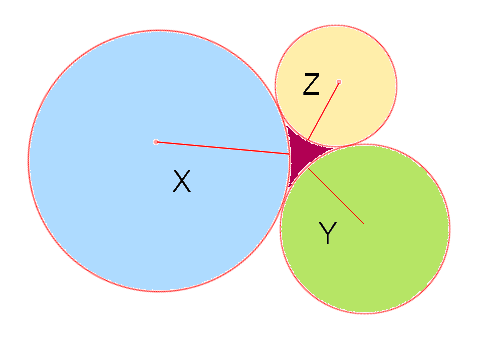
If three circles with radii x,y, and z make tangents on each other as shown, what will be the area of the figure(magenta colored) formed between them in terms of x,y, and z?
I am posting my attempt below
21{(x2+xy+xz+yz)∗sin(cos−1(x2+xy+xz+yzx2+xy+xz−yz))−x2cos−1(x2+xy+xz+yzx2+xy+xz−yz)−y2cos−1(y2+xy+yz+xzy2+xy+yz−xz)−z2cos−1(z2+xz+yz+xyz2+xz+yz−xy)}
#Geometry
#AreaBetweenCurves
#Circles

Easy Math Editor
This discussion board is a place to discuss our Daily Challenges and the math and science related to those challenges. Explanations are more than just a solution — they should explain the steps and thinking strategies that you used to obtain the solution. Comments should further the discussion of math and science.
When posting on Brilliant:
*italics*or_italics_**bold**or__bold__paragraph 1
paragraph 2
[example link](https://brilliant.org)> This is a quote# I indented these lines # 4 spaces, and now they show # up as a code block. print "hello world"\(...\)or\[...\]to ensure proper formatting.2 \times 32^{34}a_{i-1}\frac{2}{3}\sqrt{2}\sum_{i=1}^3\sin \theta\boxed{123}Comments
Can you please elaborate on how you produced the formula.
Log in to reply
Form a triangle with the circles' origins as vertices.This should be equal to the magenta area plus some sectors of each circle. Minus the sectors and you get the above equation(angles assumed in radian.)
Area of triangle - sum of the areas of three sectors
Yeah, it works out fine. I get the same result, although not exactly with the same expression.
"Update on the formula to calculate the magenta area": This one works too :)(angles are again assumed in radian) x2yz+xy2z+xyz2−2x2[sin−1(2x+2yy+z)+sin−1(2x+2zy+z)]−2y2[sin−1(2x+2yx+z)+sin−1(2y+2zx+z)]−2z2[sin−1(2x+2zx+y)+sin−1(2y+2zx+y)]